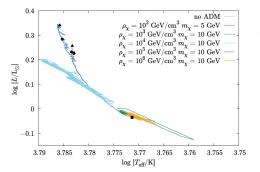February 20, 2012 feature
Stars containing dark matter should look different from other stars

(PhysOrg.com) -- Finding evidence for dark matter – the unknown substance that theoretically makes up 23% of the universe – has been one of the biggest challenges in modern cosmology. Several experiments are underway to detect dark matter candidates known as Weakly Interacting Massive Particles (WIMPs) as they travel through the Earth. And experiments at the Large Hadron Collider (LHC) are trying to produce WIMPs through proton beam collisions. Now in a new study, scientists have shown that feebly annihilating dark matter particles captured inside a star can provide an additional source of energy to the star, resulting in changes to its structure and appearance. Observing these stars could potentially offer scientists a tool to detect and analyze this kind of dark matter.
The scientists, Fabio Iocco who is currently at the Oskar Klein Center for CosmoParticle Physics in Stockholm; Marco Taoso, currently at the University of British Columbia in Vancouver; Florent Leclercq of the University of Paris and Ecole Polytechnique ParisTech in Palaiseau, France; and Georges Meynet of the University of Geneva in Sauverny, Switzerland, have published their study in a recent issue of Physical Review Letters.
In their study, the researchers focused on a type of dark matter called asymmetric dark matter (ADM), which can be loosely categorized as WIMPs. Due to an asymmetry between ADM particles and their antiparticles, the ADM particles are nonannihilating or, at most, feebly annihilating. As a result of the low annihilation rate, it would be nearly impossible to detect ADM through the indirect methods commonly used for searching for annihilating dark matter candidates.
However, when ADM particles accumulate in stars, the particles can weakly interact with the star matter’s nuclei, producing an additional energy transport mechanism in the star’s core. Previous theoretical studies have shown that this mechanism can modify the density and temperature of the star, which can provide a way to indirectly detect ADM.
Here, the scientists have taken the next step and applied this strategy to main sequence stars in environments with high ADM densities. Main sequence stars have a specific relationship between their temperature (or color) and brightness, which is illustrated on a Hertzsprung–Russell (HR) diagram. In general, the hotter a star, the brighter it is.
However, when a main sequence star contains ADM, it deviates from the standard path in the HR diagram in two possible ways, depending on the ADM density. At low densities, the ADM-driven energy transport mechanism makes the star brighter (and bigger) in relation to its temperature, moving the star above the standard path. At high densities, the same mechanism makes the star colder (and smaller) in relation to its luminosity, moving it to the right of the standard path.
As the researchers explain, these deviations result from a complex interaction between the ADM and the star, which begins when ADM particles scatter off the star matter’s nuclei. Because the larger ADM particles can travel further than the nuclei, the dark matter transports the heat energy generated by these interactions out of the star’s core, resulting in a sink of energy in the core. At low ADM densities, the star’s nuclear energy generation is reduced in the very center of the core, and the star tries to compensate by increasing nuclear energy production outside the core. The increased nuclear reaction rate allows the star to achieve a new equilibrium, but it also makes the star bigger and brighter. At high ADM densities, the dark matter reduces nuclear generation in the entire nuclear core. The overwhelmed star contracts, becoming smaller and colder.
The scientists calculated that the effects should be greatest for stars with masses around that of our Sun or a little lower. This is good news, considering 60% of the stellar mass in the Milky Way is expected to exist in the range of 0.1 to 1.0 solar masses.
The bad news, on the other hand, is that these stars must reside in environments with an ADM density of at least 100 GeV/cm3, which is about 200 times higher than the estimated 0.4 GeV/cm3 density that exists near our Sun. Large amounts of dark matter are thought to exist in the center of the Milky Way and in the centers of nearby dwarf galaxies. The researchers caution that the chances of clearly observing stars in these distant environments could be difficult. Current observational techniques of stars at these distances involve large uncertainties of the stars’ temperatures and luminosities, so their placement on the HR diagram would be somewhat unclear.
However, the scientists also note that it’s possible that stars could capture ADM in an environment rich with dark matter, and then migrate somewhere else in the galaxy, perhaps closer to us. In this case, the scientists predict that the effects of dark matter would still be visible and more easily detectable.
“Observing one of these stars would be at the same time a probe of the cross section between ADM and normal matter, their mass, and the existence of a mild dark matter cusp at the Galactic Center,” Iocco told PhysOrg.com. “Which would be quite stunning.”
“Would we not have any positive observation, we could still use the lack of observations to rule out some cross sections and masses, given our reliance on the resilience of the dark matter cusp at the Galactic Center,” he said. “It would be an additional, independent probe of those ADM properties, which is much needed nowadays.”
More information: Fabio Iocco, et al. “Main Sequence Stars with Asymmetric Dark Matter.” Physical Review Letters 108, 061301 (2012). DOI: 10.1103/PhysRevLett.108.061301
Journal information: Physical Review Letters
Copyright 2012 PhysOrg.com.
All rights reserved. This material may not be published, broadcast, rewritten or redistributed in whole or part without the express written permission of PhysOrg.com.



















